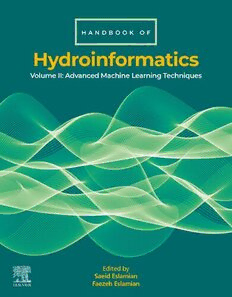
Handbook of HydroInformatics: Volume II: Advanced Machine Learning Techniques PDF
Preview Handbook of HydroInformatics: Volume II: Advanced Machine Learning Techniques
Handbook of HydroInformatics This page intentionally left blank Handbook of HydroInformatics Volume II: Advanced Machine Learning Techniques Edited by Saeid Eslamian DepartmentofWaterEngineering,CollegeofAgriculture,IsfahanUniversityofTechnology,Isfahan,Iran Faezeh Eslamian McGill University, Montreal, QC, Canada Elsevier Radarweg29,POBox211,1000AEAmsterdam,Netherlands TheBoulevard,LangfordLane,Kidlington,OxfordOX51GB,UnitedKingdom 50HampshireStreet,5thFloor,Cambridge,MA02139,UnitedStates Copyright©2023ElsevierInc.Allrightsreserved Nopartofthispublicationmaybereproducedortransmittedinanyformorbyanymeans,electronicor mechanical,includingphotocopying,recording,oranyinformationstorageandretrievalsystem,without permissioninwritingfromthepublisher.Detailsonhowtoseekpermission,furtherinformationaboutthe Publisher’spermissionspoliciesandourarrangementswithorganizationssuchastheCopyrightClearance CenterandtheCopyrightLicensingAgency,canbefoundatourwebsite:www.elsevier.com/permissions. ThisbookandtheindividualcontributionscontainedinitareprotectedundercopyrightbythePublisher(other thanasmaybenotedherein). Notices Knowledgeandbestpracticeinthisfieldareconstantlychanging.Asnewresearchandexperiencebroadenour understanding,changesinresearchmethods,professionalpractices,ormedicaltreatmentmaybecome necessary. Practitionersandresearchersmustalwaysrelyontheirownexperienceandknowledgeinevaluatingandusing anyinformation,methods,compounds,orexperimentsdescribedherein.Inusingsuchinformationormethods theyshouldbemindfuloftheirownsafetyandthesafetyofothers,includingpartiesforwhomtheyhavea professionalresponsibility. Tothefullestextentofthelaw,neitherthePublishernortheauthors,contributors,oreditors,assumeanyliability foranyinjuryand/ordamagetopersonsorpropertyasamatterofproductsliability,negligenceorotherwise,or fromanyuseoroperationofanymethods,products,instructions,orideascontainedinthematerialherein. ISBN:978-0-12-821961-4 ForinformationonallElsevierpublications visitourwebsiteathttps://www.elsevier.com/books-and-journals Publisher:CandiceJanco AcquisitionsEditor:MariaElekidou EditorialProjectManager:RupinderHeron ProductionProjectManager:BharatwajVaratharajan CoverDesigner:GregHarris TypesetbySTRAIVE,India – To Late George Edward Pelham Box (British Statistician: 1919 2013) “All models are wrong, but some are useful.” This page intentionally left blank Contents Contributors xiii 3. Computations of probable AbouttheEditors xvii maximum precipitation estimates Preface xix NorElizaAlias,SheikhHefzulBari, RasnaviParamasivam,and 1. Analyzingspatiotemporalvariation FarizulNizamAbdullah of land use and land cover data 1. Introduction 35 1.1 BackgroundandimportanceofPMP DinagarapandiPandi, SaravananKothadaraman, estimations 35 MohanKuppusamy,andSaeidEslamian 2. MethodologyofPMPestimation 36 2.1 Physicalmethod 36 1. Introduction 1 2.2 Statisticalmethod 37 2. Datapreparation 3 2.3 Multifractalapproach 38 3. Visualinterpretations 4 3. StatisticalPMPestimates: 4. LULCdistribution 5 Acase-study 40 5. LULCchangedetection 5 3.1 HershfieldPMPestimatesin 6. Imageinterpretation 10 Malaysia 40 7. LAImodel 10 4. Conclusions 44 8. Comparethevisualinterpretationvs References 45 imageinterpretation 12 9. Conclusions 12 4. Deep learning: Long short-term Acknowledgment 13 memoryinhydrologicaltimeseries References 13 TaesamLeeandVijayP.Singh 2. Artificial Intelligence-based model 1. Introduction 49 fusion approach in hydroclimatic 2. Modeldescriptionoflongshort-term studies memory(LSTM) 49 2.1 Neuralnetwork 49 VahidNourani,ElnazSharghi, 2.2 Recurrentneuralnetwork 51 NazaninBehfar,FahreddinSadikoglu, 2.3 LSTM 52 andSaeidEslamian 3. Trainingnetworkand 1. Introduction 15 backpropagation 53 2. Mathematicalconcepts 16 3.1 Feedforwardandbackward 2.1 Ensembletechniques 16 propagation 53 2.2 Hybridtechniques 21 3.2 Gradientdescentmethod 54 3. Someapplications 22 3.3 BackpropagationofRNN 54 3.1 Ensembletechniques 24 3.4 Backpropagationthroughtimeof 3.2 Hybridtechniques 27 RNN 55 4. Conclusions 30 3.5 Backpropagationthroughtimefor References 31 LSTM 57 vii viii Contents 4. VariantsofLSTM 59 2.1 Forestcanopywaterbalance 78 4.1 PeepholeLSTM 59 2.2 Waterbalanceintropicalforested 4.2 Gatedrecurrentunit 60 watersheds 81 4.3 MultiplicativeLSTM 60 2.3 Soilmoistureinforestareas 82 4.4 Sequence-to-sequence(seq2seq) 2.4 Geochemistryintropicalforests 84 LSTM 60 3. Measurementsoftherainfall 4.5 BidirectionalLSTM 61 interceptioncomponents 85 5. Normalizationandhyperparameter 3.1 Standardmeasurements 85 selection 62 3.2 Exsitumethodsforindividual 5.1 Normalization 62 trees 88 5.2 Estimationofhyperparameters 62 3.3 Forestparameters 89 6. LSTMapplicationsin 4. Rainfallinterceptionmodeling 90 hydrometeorologicalvariables 63 4.1 Conceptualmodels 90 6.1 LSTManditsvariantsfor 4.2 Statisticalandmachinelearningtools prediction 63 forecohydrologicaldatahandling 93 6.2 HybridLSTM 63 5. Conclusions 96 6.3 SimulationmodelingwithLSTM 64 References 96 7. Employeddeeplearningprogramsfor LSTM 64 7. Emotional artificial neural 7.1 TensorflowandKeraswith network: A new ANN model in Python 64 hydroinformatics 7.2 Matlab 65 8. Conclusions 65 VahidNourani,IbrahimKhalilUmar, Hu€seyinGo€kc¸ekus¸,andSaeidEslamian References 66 1. Introduction 105 5. Dimensionality reduction of 2. Mathematicalconceptsofemotional correlated meteorological artificialneuralnetwork 106 variables by Bayesian network- 2.1 Feedforwardneuralnetwork based graphical modeling (FFNN) 106 2.2 Emotionalartificialneuralnetwork KironmalaChandaandPrabalDas (EANN) 107 1. Introduction 69 2.3 DifferencebetweenFFNNand 2. Studyareaanddataused 70 EANN 108 2.1 Studyarea 70 2.4 Datapreprocessingandperformance 2.2 Dataused 70 evaluation 108 3. Methodology 71 2.5 Dominantinputsselection 109 4. Resultsanddiscussions 72 3. SomeapplicationsofEANN 111 4.1 Directedacyclicgraphsobtainedfrom 4. Conclusions 113 HCandMMHCalgorithms 72 References 113 4.2 Utilityoftheconditionaldependence 8. Exploringnature-basedadaptation structure 73 5. Conclusions 75 solutions for urban ecohydrology: References 75 Definitions, concepts, institutional framework, and demonstration 6. The ecohydrological function of MarioJ.AlSayah,Pierre-AntoineVersini, the tropical forest rainfall andDanielSchertzer interception: Observation and modeling 1. Introduction 117 2. Nature-basedadaptationsolutions CarlosR.Mello,Andre(cid:1) F.Rodrigues, (NBaS):Conceptualframeworkand MarcelaC.N.S.Terra,VanessaA.Mantovani, position 118 Jose(cid:1) A.JunqueiraJunior,andJose(cid:1) M.Mello 2.1 NBaS:Conceptsandterminology 118 1. Introduction 77 2.2 NBaSintheinternational,regional, 2. Canopywaterbalance:conceptsand andnationalframeworks 120 generalaspectsofthemonitoring 78 3. NbaSandecohydrology 122 Contents ix 4. Theneedforphysically-based 3.5 Modeluncertainties 164 evidence 124 3.6 Regionalizationmethodsin 4.1 Potentialandlimitationsofgreen rainfall-runoffmodeling roofs 127 (caseofungaugedbasins) 165 4.2 Greenroofs:Ameansforhybridizing 4. Conclusions 165 thegray 128 References 166 5. Conclusions 128 Furtherreading 167 5.1 Adaptbylearningandlearningto adapt 129 11. Identification of soil erosion sites 5.2 AreNBaSthewayforward? 129 in semiarid zones: Using GIS, Acknowledgments 130 remote sensing, and PAP/RAC References 130 model 9. Fuzzy-based large-scale KhadijaDiani,SaidEttazarini, teleconnection modeling of YoussefHahou,HichamElBelrhiti, WafaeAllaoui,KaoutarMounir,and monthly precipitation AbdelAliGourfi VahidNourani,HessamNajafi,ElnazSharghi, 1. Introduction 169 andSaeidEslamian 2. Materialsandmethod 170 1. Introduction 137 2.1 Studyarea 170 2. Materialsandmethods 138 2.2 PAP/RACmodelapplication 171 2.1 Teleconnection’simpacton 2.3 Theaccuracytest 173 hydroclimatologicsystems 138 3. Resultsanddiscussion 173 2.2 Proposedmethodology 139 3.1 Predictivephase 173 2.3 Associationrule 139 3.2 Descriptivephase 178 2.4 Fuzzylogic 141 3.3 Integrationphase 180 2.5 Efficiencycriteria 141 3.4 Globaldiagnosisofthetestaccuracy 2.6 Studyareaanddata 142 assessment 180 3. Resultsanddiscussion 144 4. Conclusions 182 4. Conclusions 151 References 182 References 151 12. Metrics of the water performance 10. Hydrologic models classification, engineering modeling calibration, and validation VahidNourani,ElnazSharghi, RimCherif,MarouaBouteffeha, NardinJabbarianPaknezhad,and EmnaGargouri-Ellouze,andSaeidEslamian SaeidEslamian 1. Introduction 155 1. Introduction 185 2. Hydrologicalmodelingforintegrated 2. Typesofhydro-climatologicalmodeling watermanagement 156 andmetrics 186 2.1 Classificationofhydrological 2.1 Pointprediction 186 models 157 2.2 Predictionintervalsofmodeling 193 2.2 Descriptionofsomecommon 2.3 Binaryclassification 193 hydrologicalmodeltypes 158 2.4 Inputselectionmethodsin 2.3 Rainfallrunofftransformation modeling 194 methodsinphysicalmodels 159 2.5 Decisionmakingmodels 195 2.4 Hydrologicmodelcomponents 159 2.6 Hydrographsinhydrological 3. Modelcalibrationandvalidation 161 modeling 196 3.1 Modelparameterization 161 2.7 Flow-durationcurves 197 3.2 Modelcalibration 161 2.8 Informationtheory 197 3.3 Optimizationmethodsformodel 3. Someapplicationsofthemetrics 198 calibration 162 3.1 Applicationofthepointpredictionin 3.4 Modelvalidation 164 hydro-climatologicalmodeling 198
